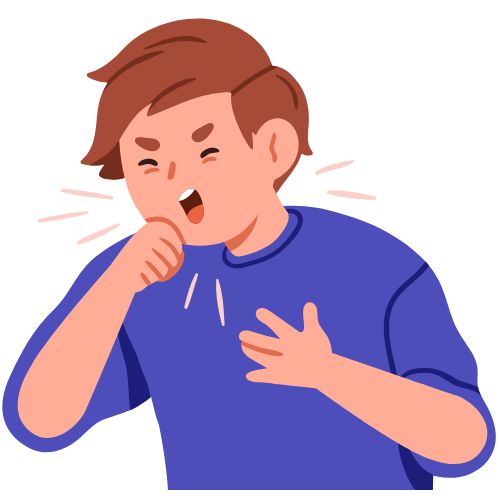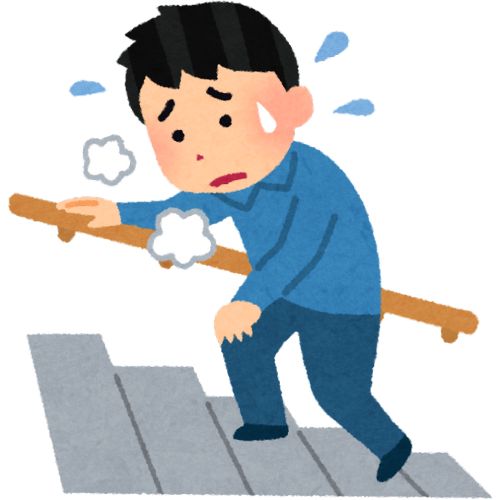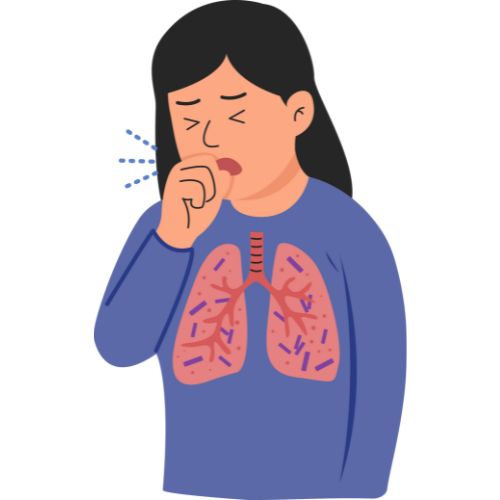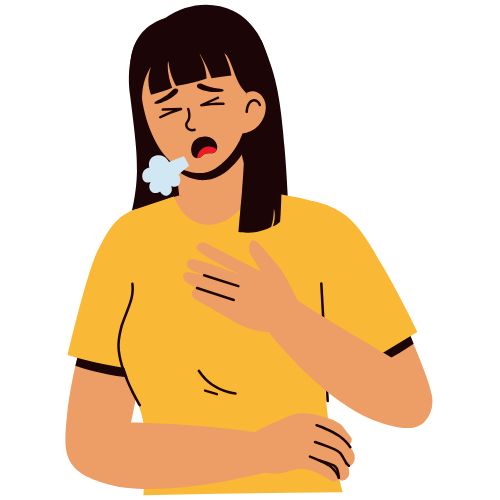Early detection of COPD is essential, as it allows treatment to begin sooner and may help prevent further loss of lung function. By learning how to recognize the symptoms and early warning signs, you can take steps to reduce their impact and maintain an active, independent lifestyle.
Typical symptoms of COPD include:

Breathlessness, especially during physical activity. It often develops gradually, so activities that were once manageable, such as climbing stairs or taking long walks, may become increasingly difficult over time.

An ongoing cough, often accompanied with coughing up sputum (phlegm). This is often the first symptom of COPD.

Recurring chest infections, such as acute bronchitis or pneumonia

Breathlessness, especially during physical activity. It often develops gradually, so activities that were once manageable, such as climbing stairs or taking long walks, may become increasingly difficult over time.
If you recognize any of these symptoms and they have been persistent, it is important to discuss them with your doctor to check for COPD, particularly if any of the following apply to you:
Other, less common symptoms of COPD, that usually only develop in the later stages of the disease include:
Without treatment, symptoms usually worsen gradually. Even while on treatment, you may sometimes experience a sudden worsening of symptoms, known as a flare-up or exacerbation.
A flare-up may present as:
These can occur several times a year, particularly during the winter months. During a flare-up, breathing often becomes more difficult, and you might also develop a fever or start coughing up yellow or green phlegm. A flare-up may require additional treatment for a few days or weeks.
A COPD flare-up can be triggered by many factors. A COPD trigger is anything that irritates your airways and amplifies your symptoms, and these triggers can vary from person to person. Common COPD triggers include:
If you have COPD, go to the emergency department or call emergency services immediately if you notice any of the following:
In the early stages, COPD may cause no or only mild symptoms. As the disease progresses, symptoms may become more noticeable. You may think that some of the symptoms are part of normal aging, and without realising it, you may start avoiding certain activities as they become increasingly difficult. As lung function gradually declines, breathing becomes harder, staying active more challenging, and the things you enjoy doing may become affected.
If your ability to be physically active is limited by breathing difficulties, or if you have noticed one or more of the typical COPD symptoms (see above) and they have been persistent, contact your GP as soon as possible. Early detection is crucial, as it allows treatment to begin sooner and may help prevent further loss of lung function. If your doctor thinks you might have COPD, you will need to have a simple lung function test called spirometry.
Call your doctor right away if your breathing suddenly gets worse or you notice signs of an infection (= flare-up, see above). Sometimes, severe symptoms require hospital care.
It is a good idea to see your GP regularly for a COPD review. These appointments are an opportunity to discuss your symptoms, how well your treatment is working, any side effects, and any challenges you may have in managing your condition. During these visits, your GP will also recommend certain vaccinations. Because people with COPD are at higher risk of becoming seriously ill from respiratory infections such as the flu or COVID-19, vaccination can help reduce the risk of complications, including worsening symptoms or further loss of lung function.
Seeing a specialist is important in the following situations:
Respiratory infections: People with COPD are more likely to get respiratory infections such as colds, the flu or an RSV (respiratory syncytial virus) infection . COPD can cause mucus to build up in the airways, which may make it easier for infections to develop. These infections can worsen COPD symptoms or even trigger a COPD flare-up. People with COPD also have a higher risk of serious complications, such as pneumonia.
Heart diseases: Your heart and lungs work together to provide the body with oxygen and get rid of a waste product, called carbon dioxide. Because COPD makes it harder to take oxygen in and get rid of carbon dioxide, the heart has to work harder to supply the body with what it needs. This extra strain increases the risk of developing certain types of heart disease, such as right-sided heart failure (cor pulmonale) and pulmonary hypertension (high blood pressure in lung arteries). COPD can also increase the chance of developing irregular heartbeats (arrhythmias). Some symptoms of heart disease, such as shortness of breath, coughing, or fatigue, are similar to COPD symptoms, which makes it difficult to tell the two conditions apart.
Lung cancer: Smoking is the leading risk factor for both COPD and lung cancer. People with COPD have a higher risk of developing lung cancer, and many of the symptoms — such as a persistent cough, shortness of breath, weight loss, and fatigue — can look very similar. If you haven’t quit smoking yet, It isit is important to do so. If you haven’t quit smoking yet, it is important to do so. Continuing to smoke after a COPD diagnosis further increases the risk of developing lung cancer. Many people with COPD qualify for lung cancer screening with a low-dose CT scan.
Chronic rhinosinusitis: About one in five people with COPD also have chronic rhinosinusitis (CRS). CRS is a medical condition defined by long-lasting inflammation inside the nose and sinuses, causing symptoms like a stuffy or runny nose, loss of smell, and facial pain. Experts still don’t fully understand how CRS and COPD affect each other, but both involve inflammation of the respiratory tract. Many people with COPD who have CRS do not even know it—up to 80% of cases go undiagnosed. Be sure to visit the dedicated section on CRS in our patient portal, where you’ll find helpful information.
Anxiety and depression: COPD can make everyday activities harder, and this can cause you to feel worried or sad. If you experience anxiety or depression, you’re not alone. Many people with COPD feel this way, and help is available. Joining a patient support group can be helpful, as it allows you to connect with others who understand what you’re going through. You can learn more about patient initiatives in the dedicated module on this COPD patient portal.
Obstructive sleep apnea (OSA) is a condition where the upper airway briefly collapses during sleep, causing repeated pauses in breathing and therefore dips in the oxygen concentration in the blood. COPD and OSA are closely linked. The frequent nocturnal dips in oxygen concentration are linked to a negative impact on quality of life and are linked with an increased risk of heart disease. Cigarette smoking is a common risk factor for developing COPD and OSA.
Gastroesophageal reflux (GERD): People with COPD are at a greater risk of developing GERD. These two conditions can also make each other worse. GERD can trigger COPD symptoms like coughing or wheezing, while COPD, especially the coughing and the use of certain COPD medications, can increase reflux.
Asthma is a long-term disease of the airways that causes symptoms similar to COPD, such as cough, wheezing, and shortness of breath. People with long-standing asthma, especially if their symptoms are not well controlled and they smoke, have a higher risk of developing COPD later in life. Some people show features of both conditions, known as asthma–COPD overlap syndrome or ACOS. Unfortunately, these patients often experience more severe symptoms, with more emergency room visits and hospitalisations. Researchers are still debating if ACOS is a separate entity or a direct consequence of asthma that is poorly controlled. Be sure to visit the dedicated section on asthma in our patient portal, where you’ll find helpful information.
Diabetes: People with COPD are at a higher risk of developing diabetes. Smoking is a common risk factor for both conditions. In addition, oral steroids used to treat COPD flare-ups can raise blood sugar levels and increase the chance of developing diabetes. Some scientific studies have also shown that reduced lung function itself may be linked to a higher risk of diabetes.
Osteoporosis: People with COPD have a higher risk of developing osteoporosis (weak or brittle bones). This can be due to several factors, such as older age, reduced physical activity, smoking, and low body weight or poor nutrition. In addition, oral steroids that are sometimes used to treat COPD flare-ups can further increase the risk when taken repeatedly.
Kidney disease: People with COPD are more likely to have kidney problems. Both conditions share risk factors such as smoking, high blood pressure, and older age. The long-term inflammation in COPD and changes in oxygen and carbon dioxide levels can also strain the kidneys, which help to balance acids, salts, and fluids in the body.
If the kidneys do not work well, waste products can build up, causing tiredness, swelling, or changes in how medicines work. Regular kidney checks are therefore important to detect problems early and prevent complications.
This website does not provide medical advice.
The information, including but not limited to, text, graphics, images, and other material contained on this website is for informational purposes only. No material on this site is intended to be a substitute for professional medical advice, diagnosis, or treatment and/or medical treatment of a qualified physician or healthcare provider. EUFOREA is not a medical organisation and cannot provide specific medical advice to patients via the Internet and/or E-mail. All patients are encouraged to direct their specific questions to their personal physicians. EUFOREA presents this information to patients so that patients can understand and participate in their own medical care. EUFOREA strongly emphasises that the information contained on this website is not a substitute for thorough evaluation and treatment by a qualified healthcare provider.
© 2025 - EUFOREA - All rights reserved. All content on this portal, such as text, graphics, logos and images, is the property of EUFOREA. They may not be reproduced, copied, published, stored, modified or used in any form, online or offline, without prior written permission of EUFOREA.